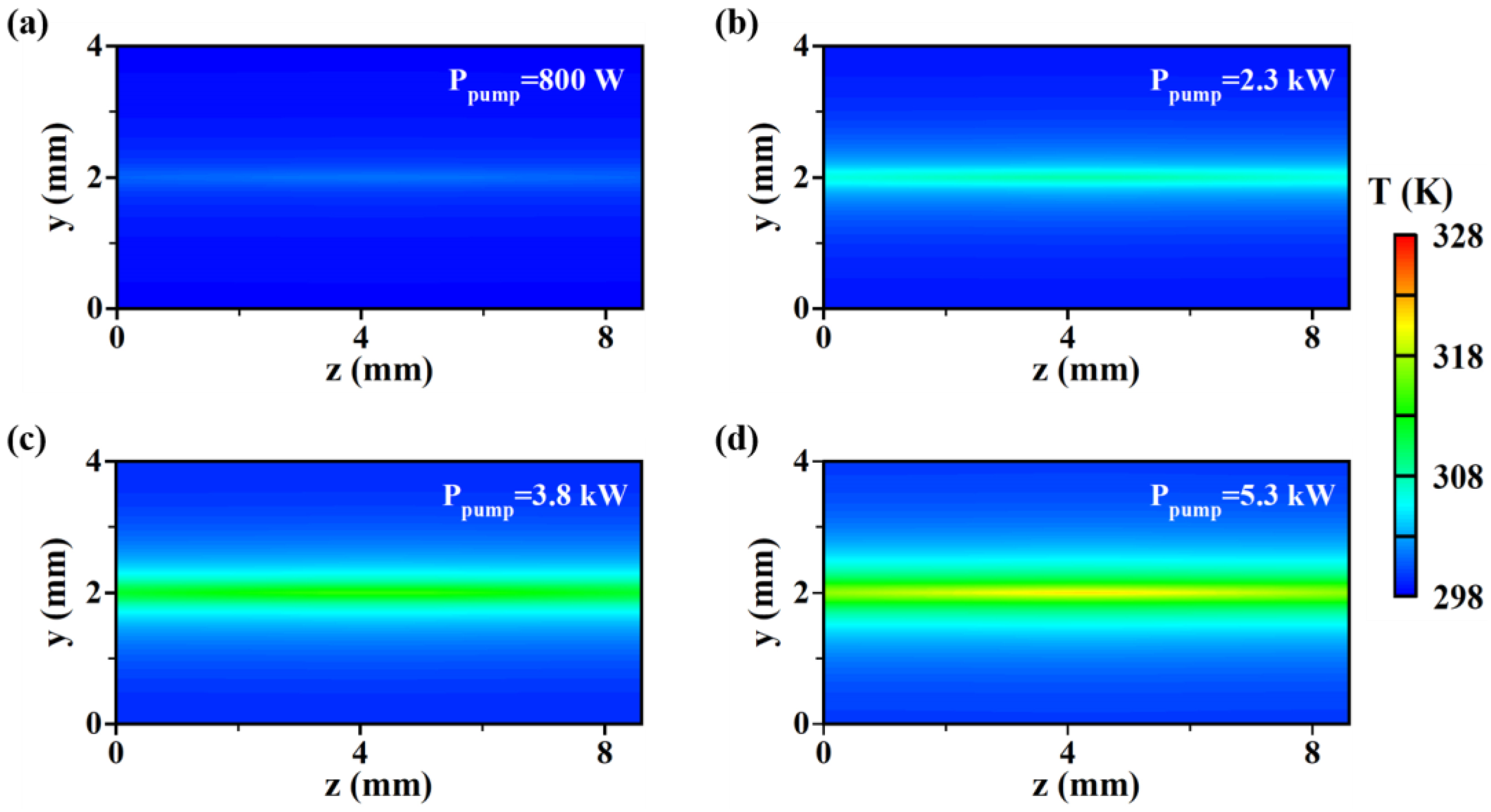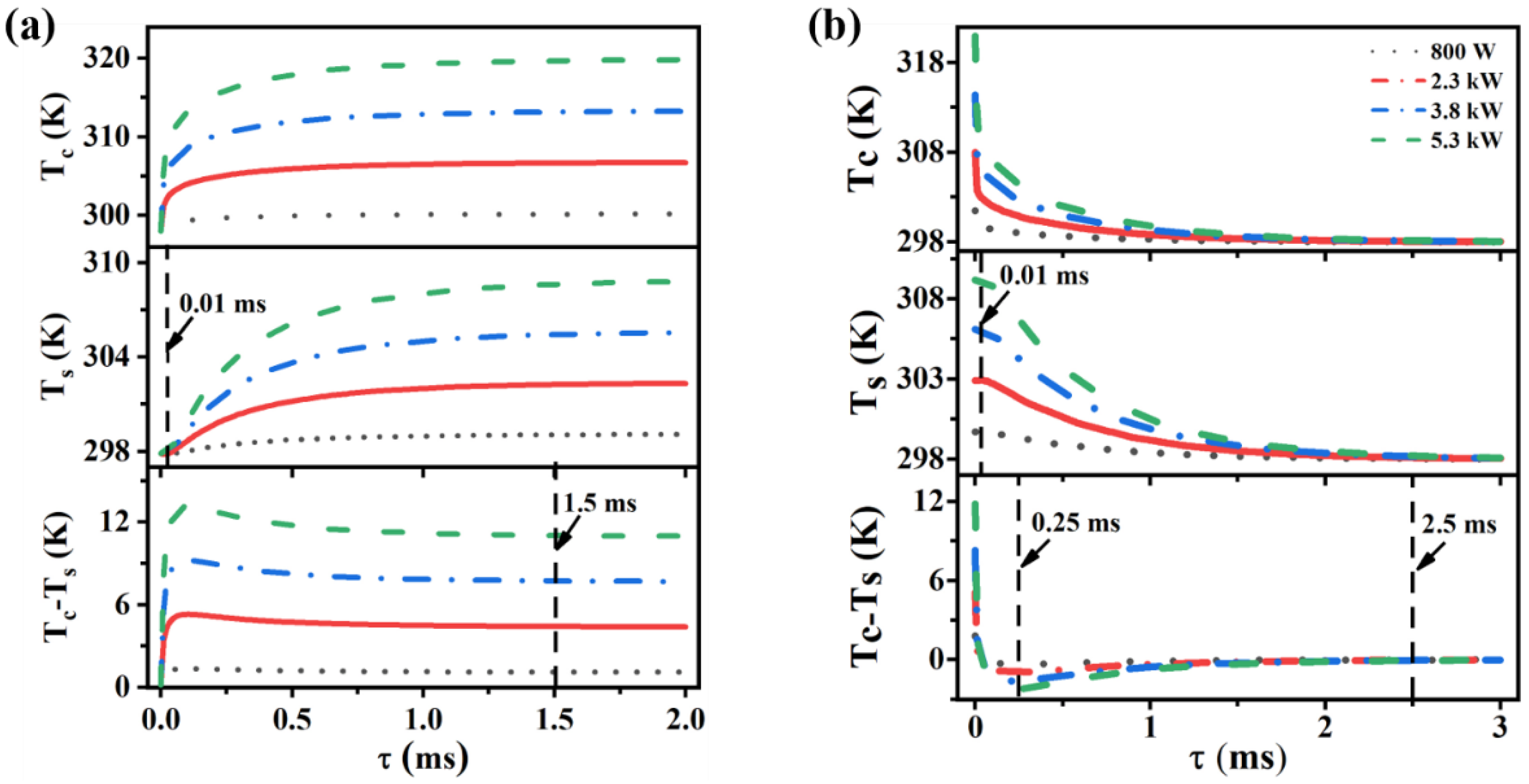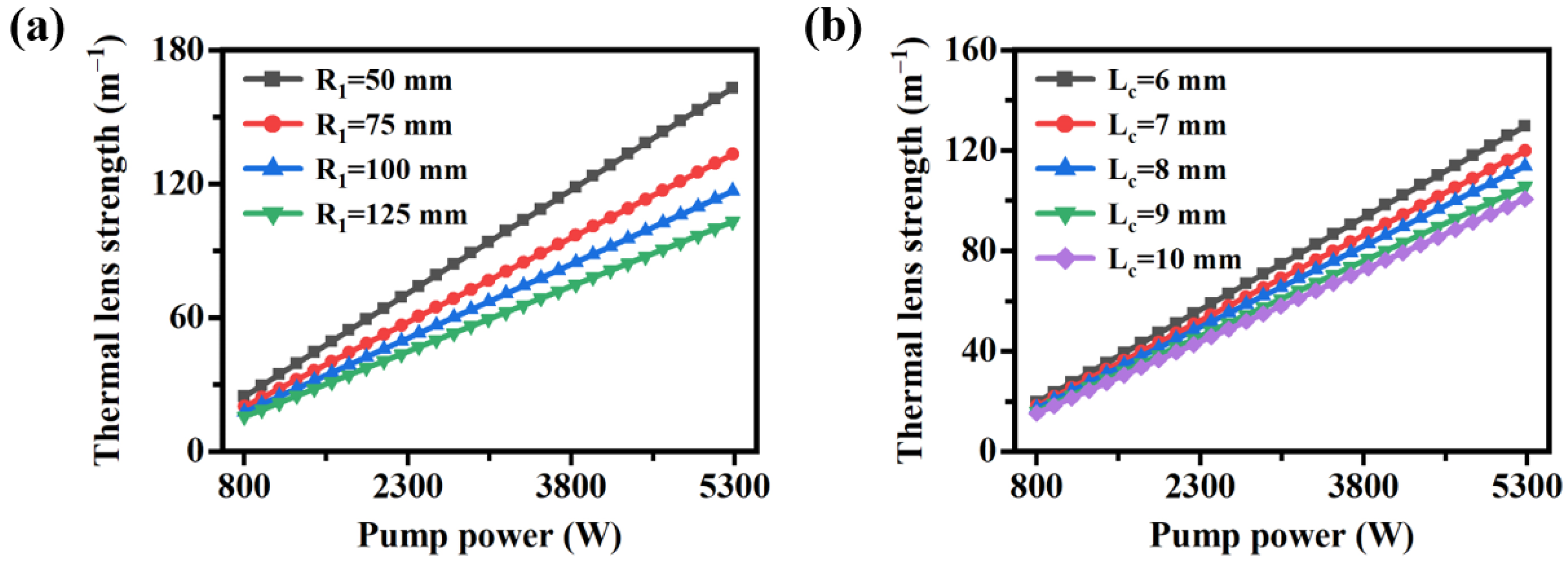Analysis of Thermal Effects in Kilowatt High Power Diamond Raman Lasers
Abstract
:1. Introduction
2. System Structure and Heat Source Model
2.1. Thermal Model of Diamond Crystal
2.2. Thermo-Elasticity Model of Diamond Crystal
2.3. Thermal Lensing Strength of Diamond Crystal
3. Results and Discussion
3.1. The Effect of Pump Power on Thermal Effect
3.1.1. Temperature Distribution at Different Pumping Power Levels
3.1.2. Thermal Stress Distribution under Different Pumping Power
3.1.3. Heat Deformation Distribution under Different Pumping Power
3.2. Effect of Resonant Cavity Configuration on the Thermal Effects
3.3. Effect of Diamond Crystal Size on the Thermal Effect
3.4. Thermal Lensing Effect Analysis
4. Conclusions
Author Contributions
Funding
Data Availability Statement
Conflicts of Interest
References
- Lubin, P.; Hughes, G.B.; Bible, J.; Bublitz, J.; Arriola, J.; Motta, C.; Suen, J.; Johansson, I.; Riley, J.; Sarvian, N.; et al. Toward directed energy planetary defense. Opt. Eng. 2014, 53, 025103. [Google Scholar] [CrossRef]
- Extance, A. Military technology: Laser weapons get real. Nature 2015, 521, 408–410. [Google Scholar] [CrossRef] [PubMed] [Green Version]
- Meng, D.; Zhang, H.; Li, M.; Lin, W.; Shen, Z.; Zhang, J.; Fan, Z. Laser technology for direct IR countermeasure system. Infrared Laser Eng. 2018, 47, 1105009. [Google Scholar] [CrossRef]
- Williams, R.J.; Spence, D.J.; Lux, O.; Mildren, R.P. High-power continuous-wave Raman frequency conversion from 1.06 µm to 1.49 µm in diamond. Opt. Express 2017, 25, 749–757. [Google Scholar] [CrossRef] [PubMed]
- Bai, Z.; Williams, R.J.; Jasbeer, H.; Sarang, S.; Kitzler, O.; Mckay, A.; Mildren, R.P. Large brightness enhancement for quasi-continuous beams by diamond Raman laser conversion. Opt. Lett. 2018, 43, 563–566. [Google Scholar] [CrossRef] [PubMed]
- Antipov, S.; Williams, R.J.; Sabella, A.; Kitzler, O.; Berhane, A.; Spence, D.J.; Mildren, R.P. Analysis of a thermal lens in a diamond Raman laser operating at 1.1 kW output power. Opt. Express 2020, 28, 15232–15239. [Google Scholar] [CrossRef] [PubMed]
- McKay, A.; Kitzler, O.; Liu, H.; Fell, D.; Mildren, R.P. High average power (11 W) eye-safe diamond Raman laser. SPIE 2012, 8551, 115–122. [Google Scholar]
- Jasbeer, H.; Williams, R.J.; Kitzler, O.; McKay, A.; Mildren, R.P. Wavelength diversification of high-power external cavity diamond Raman lasers using intracavity harmonic generation. Opt. Express 2018, 26, 1930–1941. [Google Scholar] [CrossRef]
- Li, Y.; Bai, Z.; Chen, H.; Jin, D.; Yang, X.; Qi, Y.; Ding, J.; Wang, Y.; Lu, Z. Eye-safe diamond Raman laser. Results Phys. 2020, 16, 102853. [Google Scholar] [CrossRef]
- Yang, X.; Kitzler, O.; Spence, D.J.; Bai, Z.; Feng, Y.; Mildren, R.P. Diamond sodium guide star laser. Opt. Lett. 2020, 45, 1898–1901. [Google Scholar] [CrossRef]
- Williams, R.J.; Kitzler, O.; Bai, Z.; Sarang, S.; Jasbeer, H.; McKay, A.; Antipov, S.; Sabella, A.; Lux, O.; Spence, D.J.; et al. High power diamond Raman lasers. IEEE J. Sel. Top. Quant. 2018, 24, 1–14. [Google Scholar] [CrossRef]
- Li, Y.; Ding, J.; Bai, Z.; Yang, X.; Li, Y.; Tang, J.; Zhang, Y.; Qi, Y.; Wang, Y.; Lu, Z. Diamond Raman laser: A promising high-beam-quality and low-thermal-effect laser. High Power Laser Sci. Eng. 2021, 9, 1–13. [Google Scholar] [CrossRef]
- Mildren, R.P.; Sabella, A. Highly efficient diamond Raman laser. Opt. Lett. 2009, 34, 2811–2813. [Google Scholar] [CrossRef]
- Spence, D.J.; Granados, E.; Mildren, R.P. Mode-locked picosecond diamond Raman laser. Opt. Lett. 2010, 35, 556–558. [Google Scholar] [CrossRef] [PubMed]
- Lubeigt, W.; Bonner, G.M.; Hastie, J.E.; Dawson, M.D.; Burans, D.; Kemp, A.J. Continuous-wave diamond Raman laser. Opt. Lett. 2010, 35, 2994–2996. [Google Scholar] [CrossRef]
- Sabella, A.; Piper, J.A.; Mildren, R.P. 1240 nm diamond Raman laser operating near the quantum limit. Opt. Lett. 2010, 35, 3874–3876. [Google Scholar] [CrossRef] [Green Version]
- Parrotta, D.C.; Kemp, A.J.; Dawson, M.D.; Hastie, J.E. Tunable continuous-wave diamond Raman laser. Opt. Express 2011, 19, 24165–24170. [Google Scholar] [CrossRef]
- Feve, J.P.M.; Shortoff, K.E.; Bohn, M.J.; Brasseur, J.K. High average power diamond Raman laser. Opt. Express 2011, 19, 913–922. [Google Scholar] [CrossRef]
- Lubeigt, W.; Savitski, V.G.; Bonner, G.M.; Geoghegan, S.L.; Friel, I.; Hastie, J.E.; Dawson, M.D.; Burns, D.; Kemp, A.J. 1.6 W continuous-wave Raman laser using low-loss synthetic diamond. Opt. Express 2011, 19, 6938–6944. [Google Scholar] [CrossRef] [Green Version]
- Savitski, V.G.; Reilly, S.; Kemp, A.J. Steady-State Raman Gain in Diamond as a Function of Pump Wavelength. IEEE J. Quantum Electron. 2013, 49, 218–223. [Google Scholar] [CrossRef] [Green Version]
- McKay, A.; Liu, H.; Kitzler, O.; Mildren, R.P. An efficient 14.5 W diamond Raman laser at high pulse repetition rate with first (1240 nm) and second (1485 nm) Stokes output. Laser Phys. Lett. 2013, 10, 105801. [Google Scholar] [CrossRef]
- Warrier, A.M.; Lin, J.; Pask, H.M.; Mildren, R.P.; Coutts, D.W.; Spence, D.J. Highly efficient picosecond diamond Raman laser at 1240 and 1485 nm. Opt. Express 2014, 22, 3325–3333. [Google Scholar] [CrossRef] [PubMed]
- Wattiez, A.S.; Libert, F.; Privat, A.M.; Loiodice, S.; Fialip, J.; Eschalier, A.; Courteix, C. Evidence for a differential opioidergic involvement in the analgesic effect of antidepressants: Prediction for efficacy in animal models of neuropathic pain? Br. J. Pharmacol. 2011, 163, 792–803. [Google Scholar] [CrossRef] [PubMed] [Green Version]
- Williams, R.J.; Nold, J.; Strecker, M.; Kitzler, O.; McKay, A.; Schreiber, T.; Mildren, R.P. Efficient Raman frequency conversion of high-power fiber lasers in diamond. Laser Photonics Rev. 2015, 9, 405–411. [Google Scholar] [CrossRef]
- Williams, R.J.; Kitzler, O.; McKay, A.; Mildren, R.P. Investigating diamond Raman lasers at the 100 W level using quasi-continuous-wave pumping. Opt. Lett. 2014, 39, 4152–4155. [Google Scholar] [CrossRef] [Green Version]
- Bai, Z.; Williams, R.J.; Kitzler, O.; Sarang, S.; Spence, D.J.; Mildren, R.P. 302 W quasi-continuous cascaded diamond Raman laser at 1.5 microns with large brightness enhancement. Opt. Express 2018, 26, 19797–19803. [Google Scholar] [CrossRef]
- Antipov, S.; Sabella, A.; Williams, R.J.; Kitzler, O.; Spence, D.J.; Mildren, R.P. 1.2 kW quasi-steady-state diamond Raman laser pumped by an M2 = 15 beam. Opt. Lett. 2019, 44, 2506–2509. [Google Scholar] [CrossRef]
- Sun, R.; Wu, C.T.; Yu, M.; Yu, K.; Wang, C.; Jin, G.Y. Study on the laser crystal thermal compensation of LD end-pumped Nd: YAG 1319 nm/1338 nm dual-wavelength laser. Laser Phys. 2015, 25, 125004. [Google Scholar] [CrossRef]
- Bai, F.; Huang, Z.; Liu, J.; Chen, X.; Wu, C.; Jin, G. Thermal analysis of double-end-pumped Tm: YLF laser. Laser Phys. 2015, 25, 075003. [Google Scholar]
- Cui, J.; Liu, X.; He, L.; Zhang, S.; Yang, J. Investigation of the transient thermal profile of an anisotropic crystal in a pulsed and end-pumped laser. J. Mod. Opt. 2018, 65, 1847–1854. [Google Scholar] [CrossRef]
- Zhang, H.; Wen, Y.; Zhang, L.; Zhen, F.; Liu, J.; Wu, C. Influences of Pump Spot Radius and Depth of Focus on the Thermal Effect of Tm: YAP Crystal. Curr. Opt. Photonics 2019, 3, 458–465. [Google Scholar]
- Che, X.; Liu, J.; Wu, C.; Wang, R.; Jin, G. Thermal effects analysis of high-power slab Tm: YLF laser with dual-end-pumped based on COMSOL multiphysics. Integr. Ferroelectr. 2020, 210, 197–205. [Google Scholar]
- Wang, K.; Fu, S.; Zhang, K.; Gao, M.; Gao, C. Thermal effects of the zig-zag Yb: YAG slab laser with composite crystals. Appl. Phys. B 2021, 127, 121. [Google Scholar] [CrossRef]
- Nadimi, M.; Waritanant, T.; Major, A. Thermal lensing in Nd: GdVO4 laser with direct in-band pumping at 912 nm. Appl. Phys. B 2018, 124, 170. [Google Scholar] [CrossRef]
- Liu, J.L.; Chen, X.Y.; Yu, Y.J.; Wu, C.; Bai, F.; Jin, G. Analytical solution of the thermal effects in a high-power slab Tm: YLF laser with dual-end pumping. Phys. Rev. A 2016, 93, 013854. [Google Scholar] [CrossRef]
- Wen, Y.; Wu, C.; Niu, C.; Zhang, H.; Wang, C.; Jin, G. Study on thermal effect of mid-infrared single-ended bonded Tm LuAG laser crystals. Infrared Phys. Technol. 2020, 108, 103356. [Google Scholar] [CrossRef]
- Ren, T.; Zhao, L.; Fan, Z.; Dong, J.; Wu, C.; Chen, F.; Pan, Q.; Yu, Y. Transient thermal effect analysis and laser characteristics of novel Tm: LuYAG crystal. Infrared Phys. Technol. 2022, 125, 104238. [Google Scholar] [CrossRef]
- Ramesh, K.N.; Sharma, T.K.; Rao, G. Latest advancements in heat transfer enhancement in the micro-channel heat sinks: A review. Arch. Comput. Methods Eng. 2021, 28, 3135–3165. [Google Scholar] [CrossRef]
- Liu, S.; Xie, W.; Wang, Q.; Liu, Y.; Hu, N. Thermal performance of a central-jetting microchannel heat sink designed for a high-power laser crystal. Int. J. Heat Mass Transf. 2022, 185, 122409. [Google Scholar] [CrossRef]
- Bai, Z.; Zhang, Z.; Wang, K.; Gao, J.; Zhang, Z.; Yang, X.; Wang, Y.; Lu, Z.; Mildren, R.P. Comprehensive thermal analysis of diamond in a high-power Raman cavity based on FVM-FEM coupled method. Nanomaterials 2021, 11, 1572. [Google Scholar] [CrossRef]
- Ding, J.; Li, Y.; Chen, H.; Cai, Y.; Bai, Z.; Qi, Y.; Yan, B.; Wang, Y.; Lu, Z. Thermal modeling of an external cavity diamond Raman laser. Opt. Laser Thchnol. 2022, 156, 108578. [Google Scholar] [CrossRef]
- Pashinin, V.P.; Ralchenko, V.G.; Bolshakov, A.P.; Ashkinazi, E.E.; Gorbashova, M.A.; Yorov, V.Y.; Konov, V.I. External-cavity diamond Raman laser performance at 1240 nm and 1485 nm wavelengths with high pulse energy. Laser Phys. Lett. 2016, 13, 065001. [Google Scholar] [CrossRef] [Green Version]
- Chen, H.; Bai, Z.; Zhao, C.; Yang, X.; Ding, J.; Qi, Y.; Wang, Y.; Lu, Z. Numerical simulation of long-wave infrared generation using an external cavity diamond Raman laser. Front. Phys. 2021, 9, 671559. [Google Scholar] [CrossRef]
- Kitzler, O.; McKay, A.; Mildren, R.P. High power CW diamond Raman laser: Analysis of efficiency and parasitic loss. In Proceedings of the 2012 Conference on Lasers and Electro-Optics (CLEO), San Jose, CA, USA, 6–11 May 2012. [Google Scholar]
- Tu, H.; Ma, S.; Hu, Z.; Jiang, N.; Shen, Y.; Zong, N.; Yi, J.; Yuan, Q.; Wang, X.; Wang, J. Efficient monolithic diamond Raman yellow laser at 572.5 nm. Opt. Mater. 2021, 114, 110912. [Google Scholar] [CrossRef]
- Huang, C.-Y.; Guo, B.-C.; Zheng, Z.-X.; Tsou, C.-H.; Liang, H.-C.; Chen, Y.-F. Continuous-Wave Crystalline Laser at 714 nm via Stimulated Raman Scattering and Sum Frequency Generation. Crystals 2022, 12, 1046. [Google Scholar] [CrossRef]
- Qi, Y.; Zhang, Y.; Huo, X.; Wang, J.; Bai, Z.; Ding, J.; Li, S.; Wang, Y.; Lu, Z. Analysis on the thermal effect of Pr: YLF crystal for power scaling. Opt. Eng. 2022, 61, 046108. [Google Scholar] [CrossRef]
- Chvykov, V. Ti: Sa Crystal Geometry Variation vs. Final Amplifiers of CPA Laser Systems Parameters. Crystals 2022, 12, 1127. [Google Scholar] [CrossRef]









| Parameters | Value | |
|---|---|---|
| Diamond | Thermal conductivity | 2000 Wm−1K−1 |
| Coefficient of thermal expansion | 1.1 × 10−6 K−1 | |
| Absorption coefficient | 0.375 m−1 | |
| Thermal coefficient of the refractive index | 1.5 × 10−5 K−1 | |
| Thermal conversion coefficient | 0.142 | |
| Density | 3510 kgm−3 | |
| Crystal refractive index | 2.39 @1 µm | |
| Crystal size | 1.2 mm × 4 mm × 8.6 mm | |
| Young’s modulus | 1100 GPa | |
| Poisson’s ratio | 0.069 | |
| Copper | Size | 3 mm × 8.6 mm × 8.6 mm |
| Thermal conductivity | 385 Wm−1K−1 | |
| DRLs | Pump wavelength | 1064 nm |
| Quality factor of pumping beam | 15 | |
| Stokes wavelength | 1240 nm | |
| Water | Constant temperature | 298 K (25 °C) |
| Air | Ambient temperature | 298 K (25 °C) |
Publisher’s Note: MDPI stays neutral with regard to jurisdictional claims in published maps and institutional affiliations. |
© 2022 by the authors. Licensee MDPI, Basel, Switzerland. This article is an open access article distributed under the terms and conditions of the Creative Commons Attribution (CC BY) license (https://creativecommons.org/licenses/by/4.0/).
Share and Cite
Gong, Q.; Zhang, M.; Lin, C.; Yang, X.; Fu, X.; Ma, F.; Hu, Y.; Dong, L.; Shan, C. Analysis of Thermal Effects in Kilowatt High Power Diamond Raman Lasers. Crystals 2022, 12, 1824. https://doi.org/10.3390/cryst12121824
Gong Q, Zhang M, Lin C, Yang X, Fu X, Ma F, Hu Y, Dong L, Shan C. Analysis of Thermal Effects in Kilowatt High Power Diamond Raman Lasers. Crystals. 2022; 12(12):1824. https://doi.org/10.3390/cryst12121824
Chicago/Turabian StyleGong, Qiaoxia, Mengxin Zhang, Chaonan Lin, Xun Yang, Xihong Fu, Fengying Ma, Yongsheng Hu, Lin Dong, and Chongxin Shan. 2022. "Analysis of Thermal Effects in Kilowatt High Power Diamond Raman Lasers" Crystals 12, no. 12: 1824. https://doi.org/10.3390/cryst12121824




